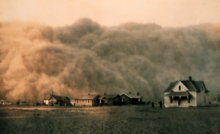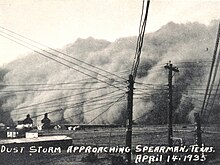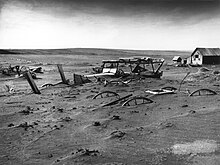Dust Bowl: Difference between revisions
m rv unexplained removal of common term to last version by DCEdwards1966 |
No edit summary |
||
| Line 1: | Line 1: | ||
{{Refimprove|date=October 2008}} |
{{Refimprove|date=October 2008}} |
||
[[Image:Dust storm CimarronCounty OK.jpg|300px|thumb|A farmer and his |
[[Image:Dust storm CimarronCounty OK.jpg|300px|thumb|A farmer and his sons during a dust storm; [[Cimarron County, Oklahoma|Cimarron County]], [[Oklahoma]], 1936.]] |
||
The '''Dust Bowl''', or the ''dirty thirties'', was a period of severe [[dust storm]]s causing major ecological and [[agriculture|agricultural]] damage to [[United States|American]] and [[Canada|Canadian]] [[prairie]] lands from 1930 to 1936 (in some areas until 1940), caused by severe [[drought]] coupled with decades of extensive farming without [[crop rotation]] or other techniques to prevent [[erosion]]. It was largely a man-made disaster caused by an abnormally severe drought combined with the deep plowing of the virgin [[topsoil]] of the [[Great Plains]], which killed the natural grasses. Such grasses normally kept the soil in place and moisture trapped, even during periods of drought and high winds. |
The '''Dust Bowl''', or the ''dirty thirties'', was a period of severe [[dust storm]]s causing major ecological and [[agriculture|agricultural]] damage to [[United States|American]] and [[Canada|Canadian]] [[prairie]] lands from 1930 to 1936 (in some areas until 1940), caused by severe [[drought]] coupled with decades of extensive farming without [[crop rotation]] or other techniques to prevent [[erosion]]. It was largely a man-made disaster caused by an abnormally severe drought combined with the deep plowing of the virgin [[topsoil]] of the [[Great Plains]], which killed the natural grasses. Such grasses normally kept the soil in place and moisture trapped, even during periods of drought and high winds. |
||
| Line 141: | Line 141: | ||
[[sv:Dust Bowl]] |
[[sv:Dust Bowl]] |
||
[[zh:黑色风暴事件]] |
[[zh:黑色风暴事件]] |
||
i hat you joey lybrook |
|||
Revision as of 18:22, 28 October 2008
This article needs additional citations for verification. (October 2008) |

The Dust Bowl, or the dirty thirties, was a period of severe dust storms causing major ecological and agricultural damage to American and Canadian prairie lands from 1930 to 1936 (in some areas until 1940), caused by severe drought coupled with decades of extensive farming without crop rotation or other techniques to prevent erosion. It was largely a man-made disaster caused by an abnormally severe drought combined with the deep plowing of the virgin topsoil of the Great Plains, which killed the natural grasses. Such grasses normally kept the soil in place and moisture trapped, even during periods of drought and high winds.
During the drought of the 1930s, with the grasses destroyed, the soil dried, turned to dust, and blew away eastwards and southwards in large dark clouds. At times the clouds blackened the sky, reaching all the way to East Coast cities such as New York and Washington, D.C. Much of the soil ended up deposited in the Atlantic Ocean. The Dust Bowl affected 100,000,000 acres (400,000 km2), centered on the panhandles of Texas and Oklahoma, and adjacent parts of New Mexico, Colorado, and Kansas.[1]
The storms of the Dust Bowl were given names such as Black Blizzard and Black Roller because visibility was reduced to a few feet (around a meter). The Dust Bowl was an ecological and human disaster. It was caused by misuse of land and years of sustained drought. Millions of acres (hectares) of farmland became useless, and hundreds of thousands of people were forced to leave their homes. Degradation of dry lands claimed peoples' cultural heritage and livelihoods. Hundreds of thousands of families from the Dust Bowl (often known as "Okies", since so many came from Oklahoma) traveled to California and other states, where they found conditions little better than those they had left. Owning no land, many traveled from farm to farm picking fruit and other crops at starvation wages. John Steinbeck later wrote the classic Pulitzer Prize-winning novel The Grapes of Wrath and also Of Mice and Men about such people.
Causes
The event's major cause was the expansion of agriculture and inappropriate methods of cultivation, which in turn has been linked to the proliferation of small farms promoted by the Homestead Act of 1862. (Arguments relying on this claim note that larger farms would have instituted the environmental safeguards that were inefficient in the short-term for smaller farms). The grass covering the prairie lands for centuries held the soil in place and maintained moisture. With deep plowing from increased farming, the grass holding the soil was eliminated. Combined with drought, the topsoil eroded into dust clouds, which further prevented rainfall. The catastrophe, which began as the economic effects of the Great Depression were intensifying, caused an exodus from Texas, Oklahoma, and the surrounding Great Plains, with more than 500,000 Americans left homeless. One storm caused 356 houses to be torn down.[2] Many Americans migrated west looking for work, while many Canadians fled to urban areas such as Toronto. Two-thirds of farmers in "Palliser's Triangle", in the Canadian province of Saskatchewan, had to rely on government aid. This was due mainly to drought, hailstorms, and erratic weather rather than to dust storms such as those occurring on the U.S. Great Plains.[3] Some residents of the Plains, especially in Kansas and Oklahoma, fell ill and died from dust pneumonia and malnutrition.[citation needed]
Geographic characteristics

The Dust Bowl area lies principally west of the 100th meridian on the High Plains, characterized by plains which vary from rolling in the north to flat in the Llano Estacado. Elevation ranges from 2,500 feet (760 m) in the east to 6,000 feet (1,800 m) at the base of the Rocky Mountains. The area is semi-arid, receiving less than 20 inches (510 mm) of rain annually; this rainfall supports the Shortgrass prairie biome originally present in the area. The region is also prone to extended drought, alternating with unusual wetness of equivalent duration.[4] During wet years, the rich soil provides bountiful agricultural output, but crops fail during dry years. Furthermore, the region is subject to winds higher than any region except coastal regions.[5]
Agricultural and settlement history
During early European and American exploration of the Great Plains, the region in which the Dust Bowl occurred was thought unsuitable for agriculture; indeed, the region was known as the Great American Desert. The lack of surface water and timber made the region less attractive for pioneer settlement and agriculture. However, following the Civil War, settlement in the area increased, encouraged by the Homestead Act and westward expansion[6][7] An unusually wet period in the Great Plains led settlers and government to believe that "rain follows the plow" and that the climate of the region had changed permanently.[8] The initial agricultural endeavors were primarily cattle ranching with some cultivation; however, a series of harsh winters beginning in 1886, coupled with overgrazing followed by a short drought in 1890, led to an expansion of land under cultivation.
Immigration began again at the beginning of the 20th century. A return of unusually wet weather confirmed the previously held opinion that the "formerly" semi-arid area could support large-scale agriculture. Technological improvements led to increased automation, which allowed for cultivation on an ever greater scale. World War I increased agricultural prices, which also encouraged farmers to drastically increase cultivation. In the Llano Estacado, farmland area doubled between 1900 and 1920, and land under cultivation more than tripled between 1925 and 1930.[9] Finally, farmers used agricultural practices that encouraged erosion.[citation needed] For example, cotton farmers left fields bare over winter months, when winds in the High Plains are highest, and burned their wheat stubble, which deprived the soil of organic matter and increased exposure to erosion.
Drought and dust storms

The unusually wet period, which encouraged increased settlement and cultivation in the Great Plains, ended in 1930. This was the year in which an extended and severe drought began. The drought caused crops to fail, leaving the plowed fields exposed to wind erosion. The fine soil of the Great Plains was easily eroded and carried east by strong continental winds.
On November 11 1933, a very strong dust storm stripped topsoil from desiccated South Dakota farmlands in just one of a series of bad dust storms that year. Then, beginning on May 9, 1934, a strong two-day dust storm removed massive amounts of Great Plains topsoil in one of the worst such storms of the Dust Bowl. The dust clouds blew all the way to Chicago where dirt fell like snow. Two days later, the same storm reached cities in the east, such as Buffalo, Boston, New York City, and Washington, D.C.[10] That winter, red snow fell on New England.
On April 14 1935, known as "Black Sunday", twenty of the worst "Black Blizzards" occurred throughout the Dust Bowl, causing extensive damage and turning the day to night. Witnesses reported that they could not see five feet in front of them at certain points. The dust storms were so bad that often roosters thought that it was night instead of day and went to sleep during them.[citation needed]
Migrations

The Dust Bowl exodus was the largest migration in American history within a short period of time. The second wave of the Great Migration by African Americans from the South to the North was larger, involving more than 5 million people, but it took place over decades, from 1940-1970.[11] By 1940, 2.5 million people had moved out of the Plains states; of those, 200,000 moved to California.[12] With their land barren and homes seized in foreclosure, many farm families were forced to leave. Migrants left farms in Oklahoma, Kansas, Texas, and New Mexico, but all were generally referred to as "Okies". The plight of Dust Bowl migrants became widely known from the novel The Grapes of Wrath by John Steinbeck.
Government response
During President Franklin D. Roosevelt's first 100 days in 1933, governmental programs designed to conserve soil and restore the ecological balance of the nation were implemented. Interior Secretary Harold L. Ickes established the Soil Erosion Service in August of 1933 under Hugh Hammond Bennett. It was later reorganized and renamed the Soil Conservation Service in 1935, and is now the Natural Resources Conservation Service (NRCS).[13]
Additionally, the Federal Surplus Relief Corporation was created after over six million pigs were slaughtered and went to waste in order to stabilize prices. The FSRC diverted agricultural commodities to relief organizations. Apples, beans, canned beef, flour and pork products were distributed through local relief channels. Cotton goods were eventually included to clothe the needy as well.[14]
In 1935, the federal government formed a Drought Relief Service to coordinate relief activities. The DRS bought cattle in counties that were designated emergency areas, for $14 to $20 a head. Those unfit for human consumption - more than 50 percent at the beginning of the program - were destroyed. The remaining cattle were given to the Federal Surplus Relief Corporation to be used in food distribution to families nationwide. Although it was difficult for farmers to give up their herds, the cattle slaughter program helped many of them avoid bankruptcy. "The government cattle buying program was a God-send to many farmers, as they could not afford to keep their cattle, and the government paid a better price than they could obtain in local markets." [15]
President Roosevelt ordered that the Civilian Conservation Corps plant a huge belt of more than 200 million trees from Canada to Abilene, Texas, to break the wind, hold water in the soil, and hold the soil itself in place. The administration also began to educate farmers on soil conservation and anti-erosion techniques, including crop rotation, strip farming, contour plowing, terracing and other beneficial farming practices.[16] [17]
In 1937, the federal government began an aggressive campaign to encourage Dust Bowlers to adopt planting and plowing methods that conserve the soil. The government paid the reluctant farmers a dollar an acre to practice one of the new methods. By 1938, the massive conservation effort had reduced the amount of blowing soil by 65 percent. Nevertheless, the land failed to yield a decent living.
In the fall of 1939, after nearly a decade of dirt and dust, rain finally came.
Influence on the arts
The human crisis was documented by photographers, musicians, and authors. Photographer Dorothea Lange made a name for herself while working as a photographer with the Farm Security Administration and capturing the impact of the storms. Independent artists like folk singer Woody Guthrie and novelist John Steinbeck both became famous for their depictions of life during the Dust Bowl of the 1930s.
See also
- 1936 North American heat wave
- Woody Guthrie
- Rain follows the plow
- The Plow That Broke the Plains
- Timeline of environmental events
- Natural disaster
- Desertification
- Ogallala Aquifer
References
- ^ Hakim, Joy (1995). A History of Us: War, Peace and all that Jazz. New York: Oxford University Press. ISBN 0-19-509514-6.
{{cite book}}: Cite has empty unknown parameter:|coauthors=(help) - ^ "First Missed Century:Interview:James Gregory". PBS. Retrieved 2007-03-11.
- ^ ""The Dust Bowl"". CBC. Retrieved 2007-03-11.
- ^ "A History of Drought in Colorado: lessons learned and what lies ahead" (PDF). Colorado Water Resources Research Institute. 2000.
{{cite web}}: Unknown parameter|accessmonthday=ignored (help); Unknown parameter|accessyear=ignored (|access-date=suggested) (help); Unknown parameter|month=ignored (help) - ^ "A Report of the Great Plains Area Drought Committee" (HTML). Hopkins Papers, Franklin D. Roosevelt Library. August 27 1936.
{{cite web}}: Check date values in:|date=(help); Unknown parameter|accessmonthday=ignored (help); Unknown parameter|accessyear=ignored (|access-date=suggested) (help) - ^ "The Great Plains: from dust to dust" (HTML). Planning Magazine. 1987.
{{cite web}}: Unknown parameter|accessmonthday=ignored (help); Unknown parameter|accessyear=ignored (|access-date=suggested) (help); Unknown parameter|month=ignored (help) - ^ Regions at Risk: a comparison of threatened environments (HTML). United Nations University Press. 1995.
{{cite book}}: Unknown parameter|accessmonthday=ignored (help); Unknown parameter|accessyear=ignored (|access-date=suggested) (help) - ^ Drought in the Dust Bowl Years (HTML). National Drought Mitigation Center. 2006.
{{cite book}}: Unknown parameter|accessmonthday=ignored (help); Unknown parameter|accessyear=ignored (|access-date=suggested) (help) - ^ Regions at Risk: a comparison of threatened environments (HTML). United Nations University Press. 1995.
{{cite book}}: Unknown parameter|accessmonthday=ignored (help); Unknown parameter|accessyear=ignored (|access-date=suggested) (help) - ^ Stock, Catherine McNicol (1992). Main Street in Crisis: The Great Depression and the Old Middle Class on the Northern Plains, p. 24. University of North Carolina Press. ISBN 0807846899.
- ^ "In Motion: African American Migration Experience, The Second Great Migration". Retrieved 2007-03-18.
- ^ Worster, Donald (1979). Dust Bowl: The Southern Plains in the 1930's. Oxford University Press.
{{cite book}}: Cite has empty unknown parameter:|coauthors=(help) - ^ Steiner, Frederick (2008). The Living Landscape, Second Edition: An Ecological Approach to Landscape Planning, p. 188. Island Press. ISBN 1597263966.
- ^ http://www.pbs.org/wgbh/amex/dustbowl/timeline/
- ^ Monthly Catalog, United States Public Documents, By United States Superintendent of Documents, United States Government Printing Office, Published by G.P.O., 1938
- ^ Texas By Federal Writers' Project, Writers' Program (Tex.), Writers' Program Texas, p. 16
- ^ Chronicles of Oklahoma By James Shannon Buchanan, Oklahoma Historical Society, p. 224
Bibliography
- Woody Guthrie, The (Nearly) Complete Collection of Woody Guthrie Folk Songs, Ludlow Music, New York (1963).
- Alan Lomax, Woody Guthrie, Pete Seeger, Hard-Hitting Songs for Hard-Hit People, Oak Publications, New York (1967).
- C. Vann Woodward, The Origins of the New South, Louisiana State University Press (1967).
- The Worst Hard Time: The Untold Story of Those Who Survived The Great American Dust Bowl, Timothy Egan, Houghton Mifflin Company, New York, 2006, hardcover. ISBN 0-618-34697-X.
- The Dust Bowl: Men, Dirt, and Depression, Paul Bonnifield, University of New Mexico Press, Albuquerque, New Mexico, 1978, hardcover. ISBN 0-8263-0485-0.
- Survival in the Storm: The Dust Bowl Diary of Grace Edwards, Dalhart, Texas, 1935, Katelan Janke, Scholastic (September 2002). ISBN 0-439-21599-4.
- Out of the Dust, Karen Hesse, Scholastic Signature. New York First Edition, 1997, hardcover (paperback January 1999). ISBN 0-590-37125-8.
External links
- NASA Explains "Dust Bowl" Drought
- The Dust Bowl photo collection
- The Dust Bowl (EH.Net Encyclopedia)
- Black Sunday, April 14, 1935, Dodge City, KS
- The Bibliography of Aeolian Research
- Surviving the Dust Bowl, Black Sunday (April 14, 1935)
- The Plow That Broke The Plains
- Youtube Video: "The Great Depression, Displaced Mountaineers in Shenandoah National Park, and the Civilian Conservation Corps (C.C.C.)"
- Farming in the 1930s (Wessels Living History Farm)
- The Dust Bowl (University of South Dakota)
- Black Blizzard (The History Channel)
- Flash: Out of the Dust (The Modesto Bee)
i hat you joey lybrook
- Great Depression in the United States
- Agriculture in the United States
- Forced migrations in the United States
- History of the American West
- Environmental disasters in the United States
- History of the United States (1918–1945)
- Natural disasters in Kansas
- Natural disasters in Oklahoma
- Natural disasters in Texas
- Droughts
- Environment of Kansas
- Environment of Oklahoma
- Environment of Texas
